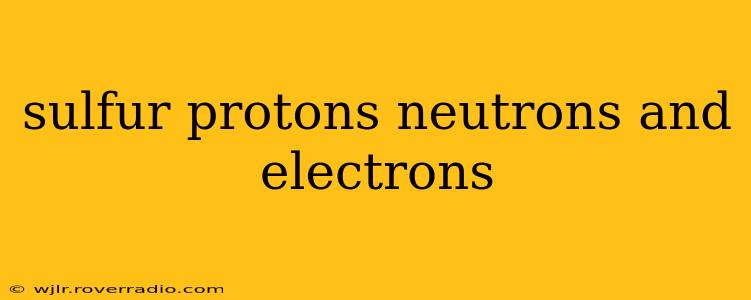Sulfur, a vibrant yellow nonmetal with the chemical symbol S, plays a crucial role in various biological and industrial processes. Understanding its atomic structure, particularly the number of protons, neutrons, and electrons, is key to comprehending its properties and behavior. This article delves into the specifics of sulfur's atomic composition, addressing common questions and providing a detailed explanation.
How many protons, neutrons, and electrons does sulfur have?
This is the fundamental question regarding sulfur's atomic structure. The answer depends on the specific isotope of sulfur being considered. The most common isotope, sulfur-32 (³²S), contains:
- 16 Protons: The number of protons defines an element. All sulfur atoms have 16 protons. This is its atomic number.
- 16 Neutrons: The number of neutrons can vary within isotopes of the same element. In sulfur-32, there are 16 neutrons.
- 16 Electrons: In a neutral atom, the number of electrons equals the number of protons. Therefore, sulfur-32 has 16 electrons.
It's crucial to remember that other isotopes of sulfur exist, differing only in their neutron count. These isotopes have the same number of protons and electrons but a different mass number (protons + neutrons).
What are the different isotopes of sulfur?
Sulfur has several naturally occurring isotopes, including:
- Sulfur-32 (³²S): The most abundant isotope (approximately 95%).
- Sulfur-33 (³³S): A less abundant stable isotope.
- Sulfur-34 (³⁴S): Another stable isotope, less abundant than ³²S.
- Sulfur-36 (³⁶S): A stable isotope with the lowest natural abundance.
These isotopes behave chemically identically, but their different masses influence certain physical properties, particularly those related to mass spectrometry and isotopic fractionation in natural processes.
How many valence electrons does sulfur have?
Sulfur's electron configuration is [Ne] 3s² 3p⁴. This means it has 6 valence electrons – the electrons in its outermost shell. These valence electrons are crucial for understanding sulfur's chemical bonding and reactivity. Sulfur readily forms covalent bonds with other atoms, often sharing two electrons to achieve a stable octet.
What is the atomic mass of sulfur?
The atomic mass of sulfur is approximately 32.06 atomic mass units (amu). This is a weighted average of the masses of all naturally occurring sulfur isotopes, taking into account their relative abundances. It's not the mass of a single sulfur atom but a representative value reflecting the isotopic mixture found in nature.
How does the number of neutrons affect sulfur's properties?
While the number of protons determines an element's chemical properties, the number of neutrons affects its physical properties, primarily its mass and stability. Isotopes with differing neutron numbers can exhibit slight variations in reactivity rates in certain circumstances, but the overall chemical behavior remains consistent across isotopes. Some isotopes might be radioactive, while others are stable. All stable isotopes of sulfur are naturally occurring.
Where can I find more information on sulfur's atomic structure?
For more in-depth information on sulfur's atomic structure, isotopic abundances, and chemical properties, you can consult reputable chemistry textbooks, scientific journals, and online resources like the NIST Atomic Spectra Database.
This comprehensive overview provides a detailed understanding of sulfur's protons, neutrons, and electrons, covering fundamental aspects and addressing common queries. Remember, the number of protons uniquely defines the element, while the number of neutrons distinguishes between isotopes. Understanding this is vital for grasping sulfur's diverse applications in various scientific fields.
